|
Paul Deckret
Mt. Karamatsu in Spring: A Stunning Alpine Snow Hike

Northern Nagano's Hakuba Village is best known as a world-class skiing destination that helped host the 1998 Winter Olympics and boasts five fantastic resorts within its borders. Yet, the spectacular mountains rising dramatically above Hakuba's rice paddies provide the perfect playground for a variety of outdoor sports year-round.
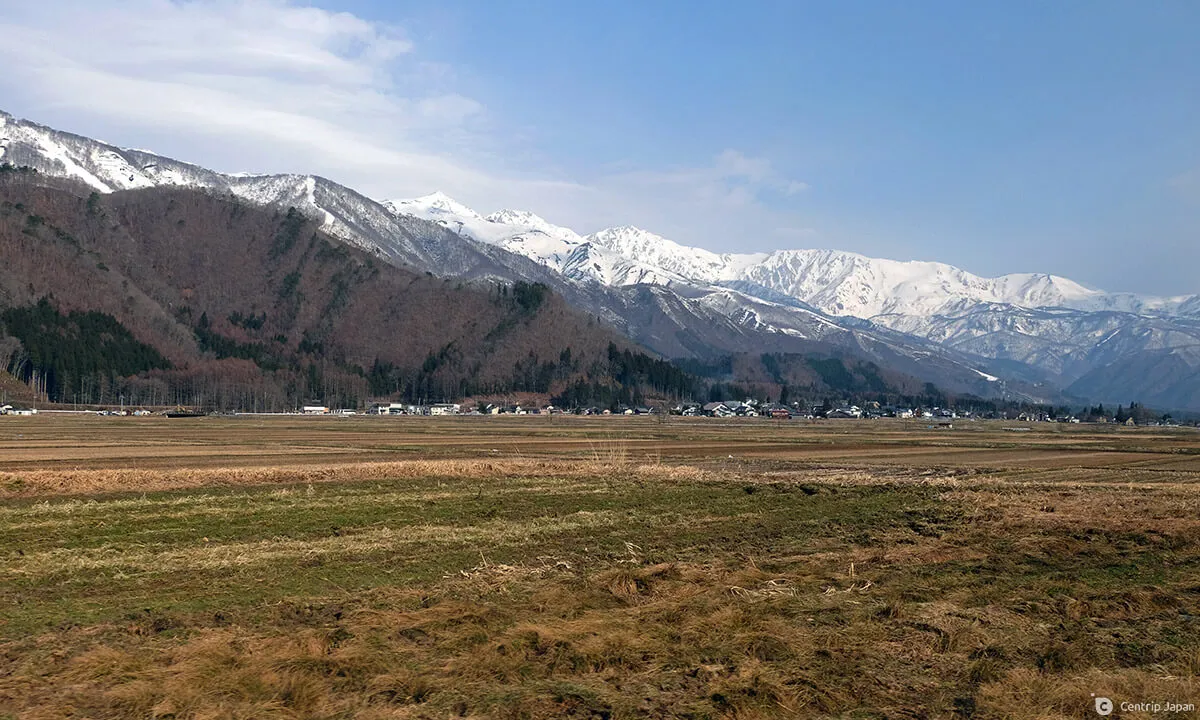 The snow-capped Northern Alps towering over the village of Hakuba
The snow-capped Northern Alps towering over the village of Hakuba
The extensive networks of trails leading up to the stately ridgeline and continuing from peak to peak are an appealing way to explore the wonders of Japan's high-alpine environments through trekking, primarily in summer.
 The final approach to the summit of Mt. Karamatsu in early April
The final approach to the summit of Mt. Karamatsu in early April
One of the area's most exceptional climbs leads up to the summit of 2,696m Mt. Karamatsu, but you don't necessarily have to wait until July or August to enjoy it. Karamatsu's popularity extends beyond the summer months, with experienced and well-equipped hikers flocking to its snowy slopes to enjoy the incredible scenery found during the spring zansetsu (remaining snow) season.
The Ushiro-Tateyama Mountain Range
The long line of craggy peaks that form Hakuba's striking backdrop is known as the Ushiro-Tateyama Range. They are a subset of the Northern Alps; specifically, the portion that extends unbroken from Kurobe Dam to their terminus at the Sea of Japan, and their name is derived from their location opposite the Tateyama massif.
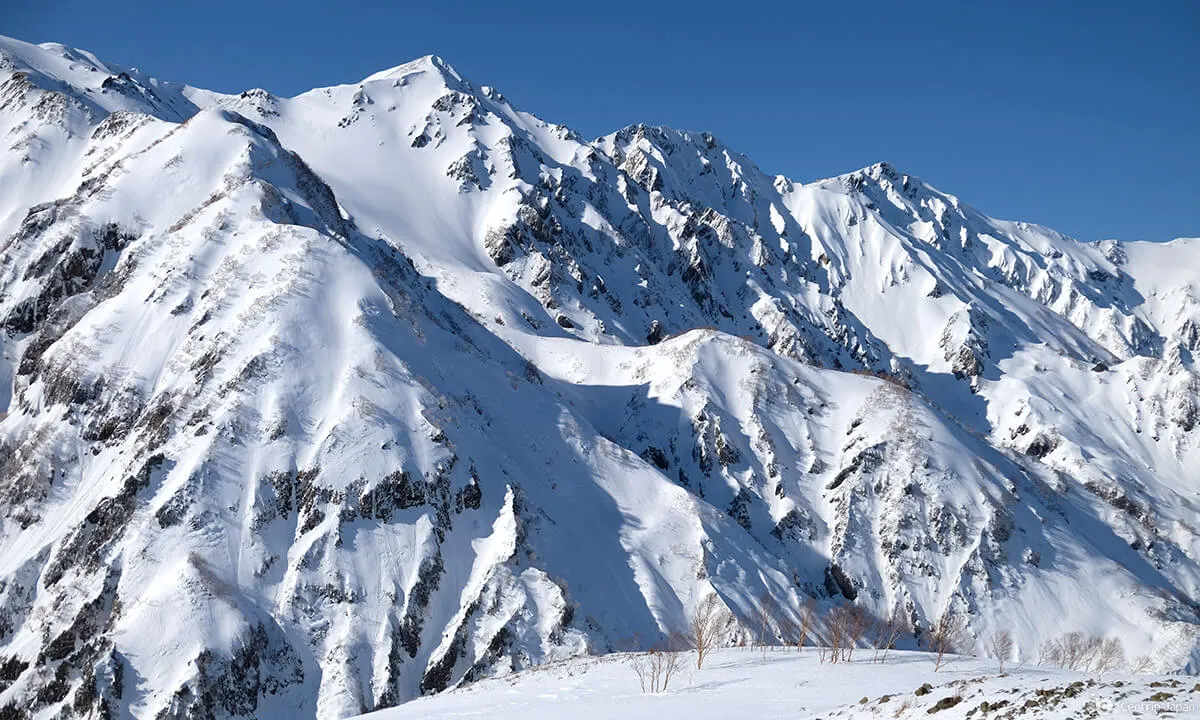 The 3 major Hakuba peaks: Mt. Hakuba Yari, Mt. Shakushi, and Mt. Shirouma
The 3 major Hakuba peaks: Mt. Hakuba Yari, Mt. Shakushi, and Mt. Shirouma
Mt. Shirouma is the chain's highest point at 2,932 meters above sea level and is perhaps its most famous symbol. Indeed, Shirouma is an alternative reading of the characters that form the village of Hakuba's name.
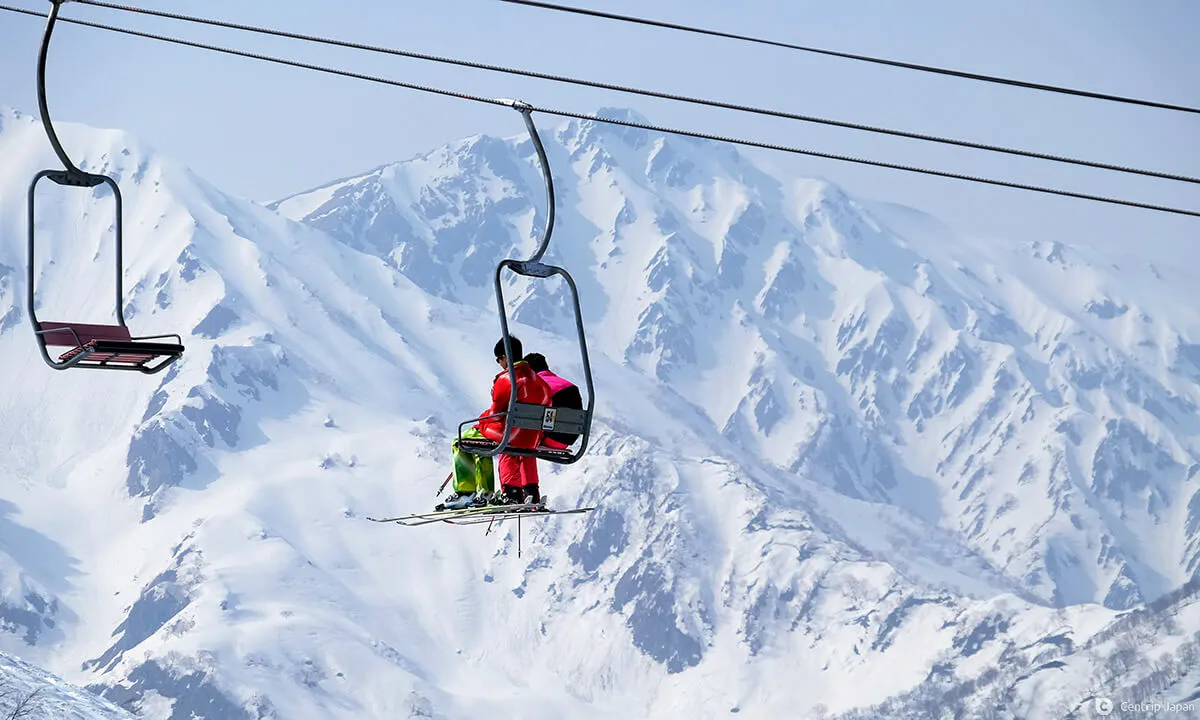 The impressive form of Mt. Shirouma as seen from the Happo-One Ski Resort
The impressive form of Mt. Shirouma as seen from the Happo-One Ski Resort
Mt. Karamatsu
Mt. Karamatsu is one of the most accessible and most popular mountains in the Hakuba area, lying in the heart of the range, approximately 10 kilometers south of Mt. Shirouma. It sits directly above the Hakuba Happo-One Ski Resort, which serves as the starting point for trips to the summit of Karamatsu. The "one" in Happo-One is often mistakenly pronounced by international visitors as the number it shares a spelling with, though the correct pronunciation is oh-nay, meaning "ridge" in Japanese. This comes from the fact that the resort is built upon a sharp, elongated ridge that starts at the foot of the mountains and stretches up to the top.
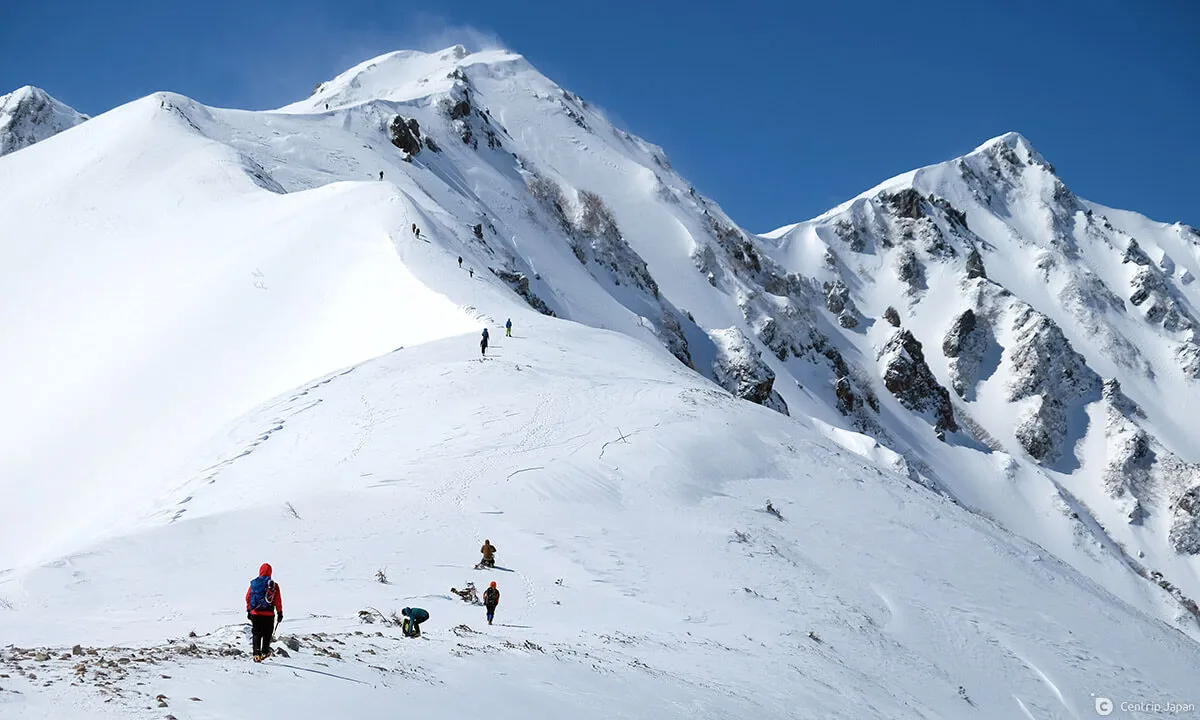 Hikers following the windswept ridge towards Mt. Karamatsu (far right)
Hikers following the windswept ridge towards Mt. Karamatsu (far right)
Climbing Mt. Karamatsu in Spring
Getting Started
Those aiming for Karamatsu's apex first need to make their way to the base of the Happo-One Ski Resort (760m) for an 8-minute ride on the Gondola Adam. After stepping off the gondola at the Usagidaira Station, it's a short snow traverse over to the next lift-assisted leg of the journey: the Alpen Quad. If it didn't already feel awkward carrying a backpack on the gondola and strolling across the ski slope to get to the chair lift, passing through the turnstile and lining up behind skiers before getting on with only hiking boots on your feet almost certainly will.
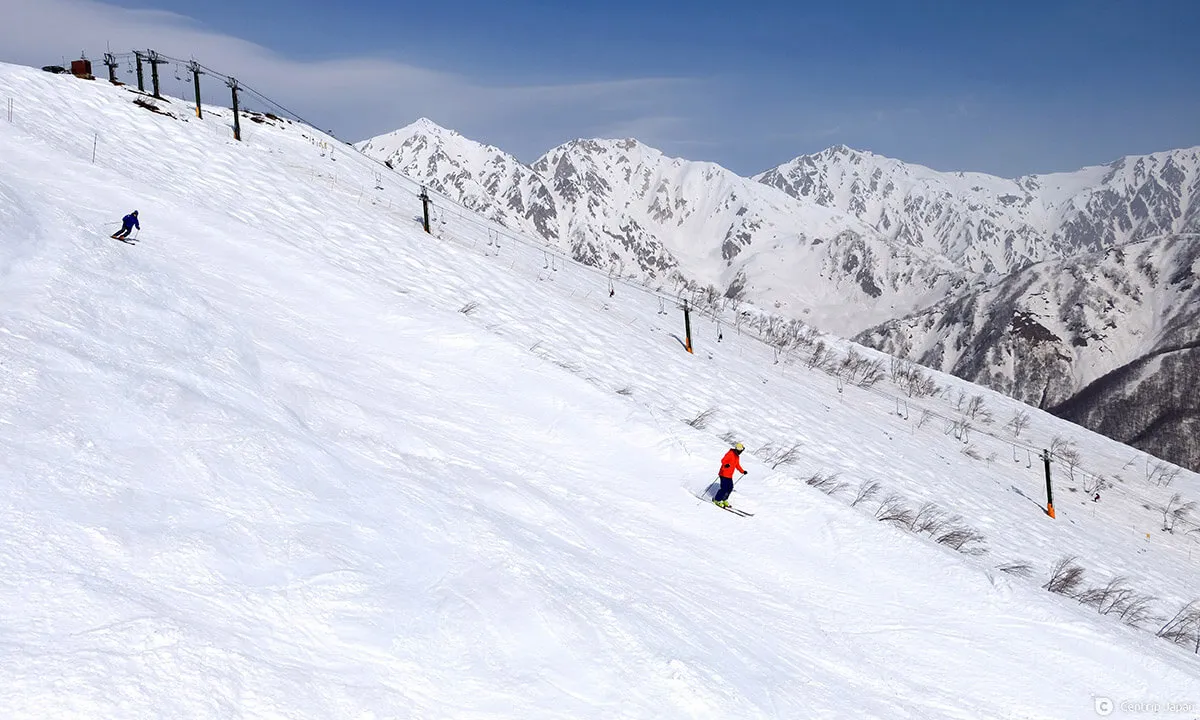 A view from the Alpen Quad lift on the way up to the top of the resort
A view from the Alpen Quad lift on the way up to the top of the resort
It's a pleasant open-air ride up towards the top of the resort, punctuated by the sights and sounds of skiers and snowboarders gliding effortlessly below you. The views of distant peaks behind you to the north and east as you hover upward are amazing enough, but cresting over the hump just before the next disembarkation point brings a new, magnificent perspective.
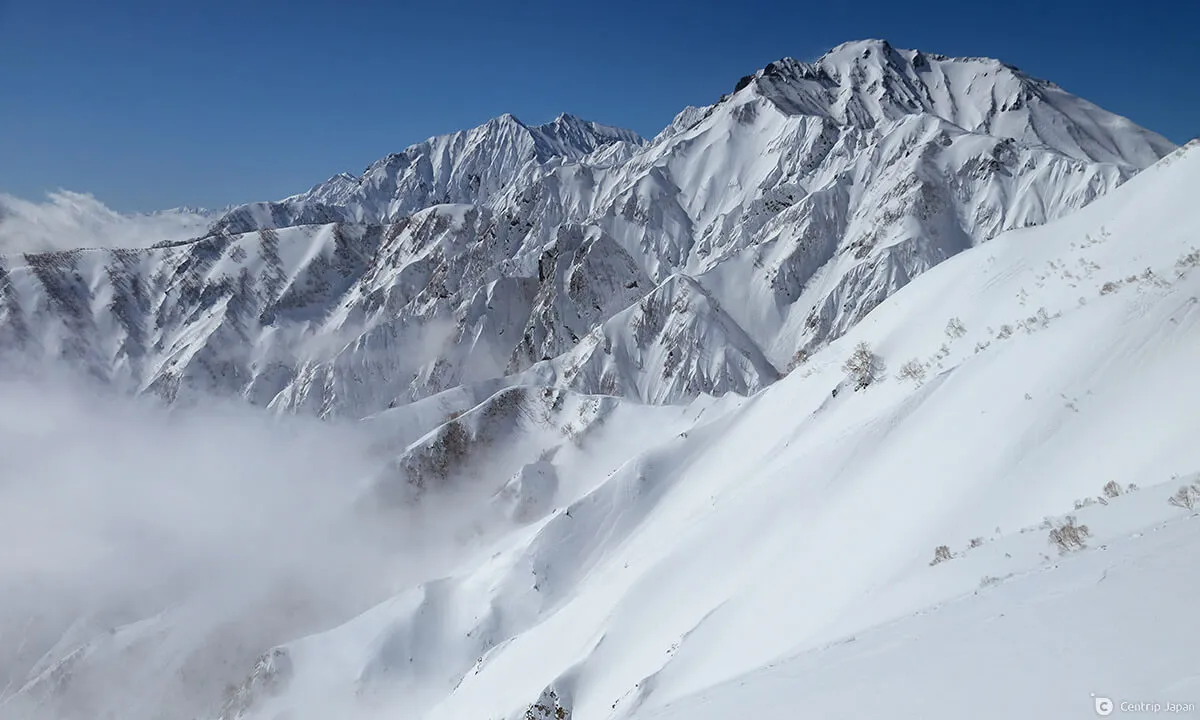 The twin peaks of Mt. Kashimayari (left) and the hulking rocky dome of Mt. Goryu (right) rising high into the sky
The twin peaks of Mt. Kashimayari (left) and the hulking rocky dome of Mt. Goryu (right) rising high into the sky
From here you can now glimpse the imposing snow-capped forms of Mt. Goryu and Mt. Kashimayari to your left, along with Mt. Shirouma and Mt. Korenge to your right, though it will be a while before Karamatsu itself comes into view.
 The Grat Quad, the final chairlift to the Happo-ike Sanso, and the start of the trek to Mt. Karamatsu
The Grat Quad, the final chairlift to the Happo-ike Sanso, and the start of the trek to Mt. Karamatsu
This wide, flat area known as Kurobishi-daira is where you transfer to the Grat Quad (1,680m) for one final 5-minute ride before dismounting from the lift in front of the Happo-ike Sanso mountain hut, at an elevation of 1,831 meters.
On the Trail
On sunny spring days, this can be a shockingly busy route, and the open space in front of Happo-ike Sanso is a vibrant staging ground for hikers and backcountry skiers stretching, snacking, sorting their gear, adding or removing layers, and stepping into their crampons or skis before starting. It's also the last place you can use the toilet, so be sure to take care of business if you need to.
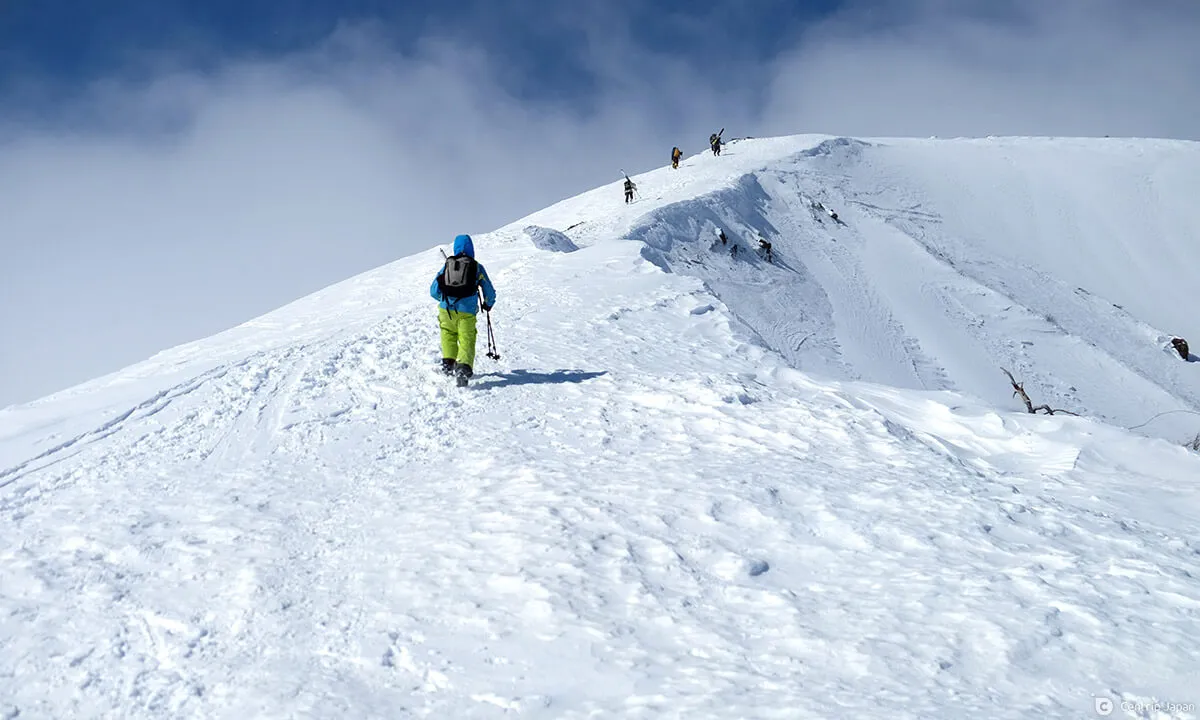 Heading into the clouds at the start of the hike up the ridge
Heading into the clouds at the start of the hike up the ridge
At this point, there are still almost five full kilometers and 900 vertical meters separating you from the top of Mt. Karamatsu, so you won't want to linger too long. The standard Yamatokogen hiking map stipulates that it takes just over 4 hours one way to the summit, though this should only be used as a general guide since the time listed is for the non-snow season.
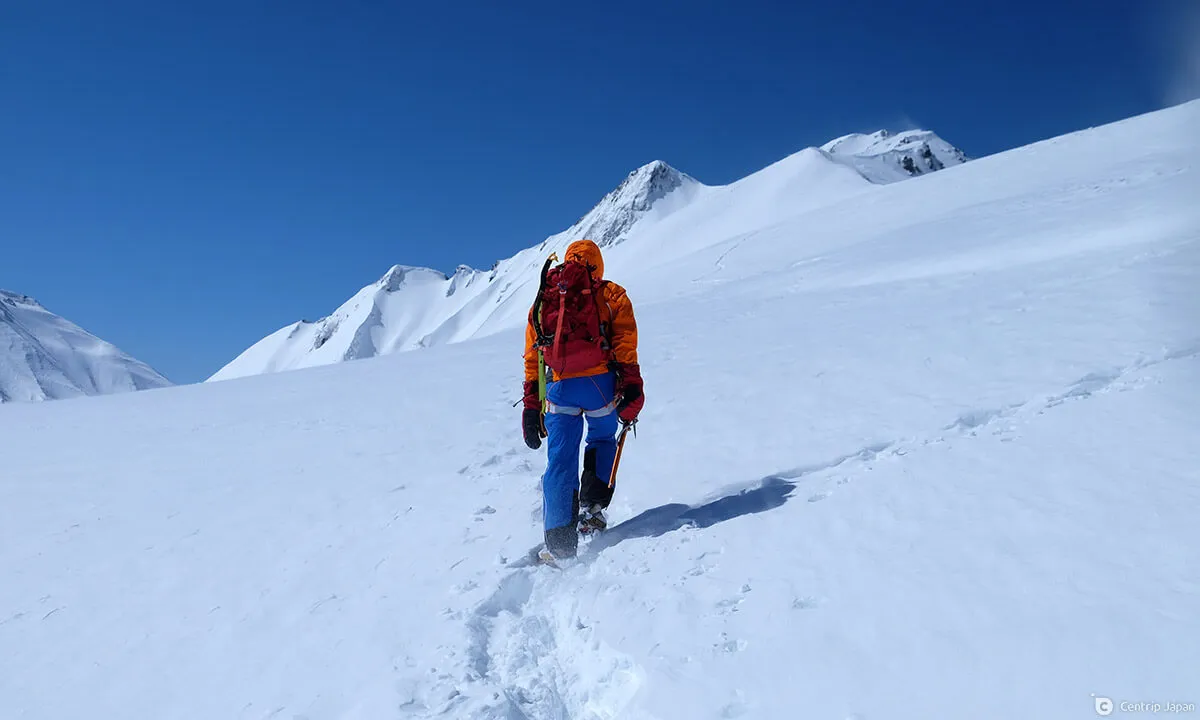 A hiker in vibrantly colored clothing stands out against the stark, white, snowy background
A hiker in vibrantly colored clothing stands out against the stark, white, snowy background
The trail itself runs right along with the crown of the ridge, ensuring outstanding, unobstructed views from the top to the bottom. This has the additional benefit of being relatively easy to navigate, and keeps hikers largely away and protected from the areas most prone to avalanches. This is one of the big reasons that Karamatsu draws crowds of mountaineers throughout the snow season, while other neighboring peaks are seldom visited in winter and spring.
 Clear days provide exceptional views across the valley to peaks including Mt. Hiuchi and Mt. Myoko
Clear days provide exceptional views across the valley to peaks including Mt. Hiuchi and Mt. Myoko
 The area above the Happo-One resort is also extremely popular with backcountry skiers
The area above the Happo-One resort is also extremely popular with backcountry skiers
Unfortunately, the exposed, elevated spine responsible for the hike's terrific views has the side effect of placing you in a prime position to be blasted by the howling winds that regularly whip across the mountain, forcing hikers to turn back short of the summit.
 Ice sculpted by intense winds clings in artistically to the summit signpost
Ice sculpted by intense winds clings in artistically to the summit signpost
In summer the path is predominantly wide, rocky, and exposed with occasional narrow passages through dense vegetation, though climbing during early spring ensures you'll be walking almost entirely on snow, well above the boulders and bushes. More and more bare earth is revealed as the seasonal snowmelt progresses, and things can look quite a bit different from March to April to May.
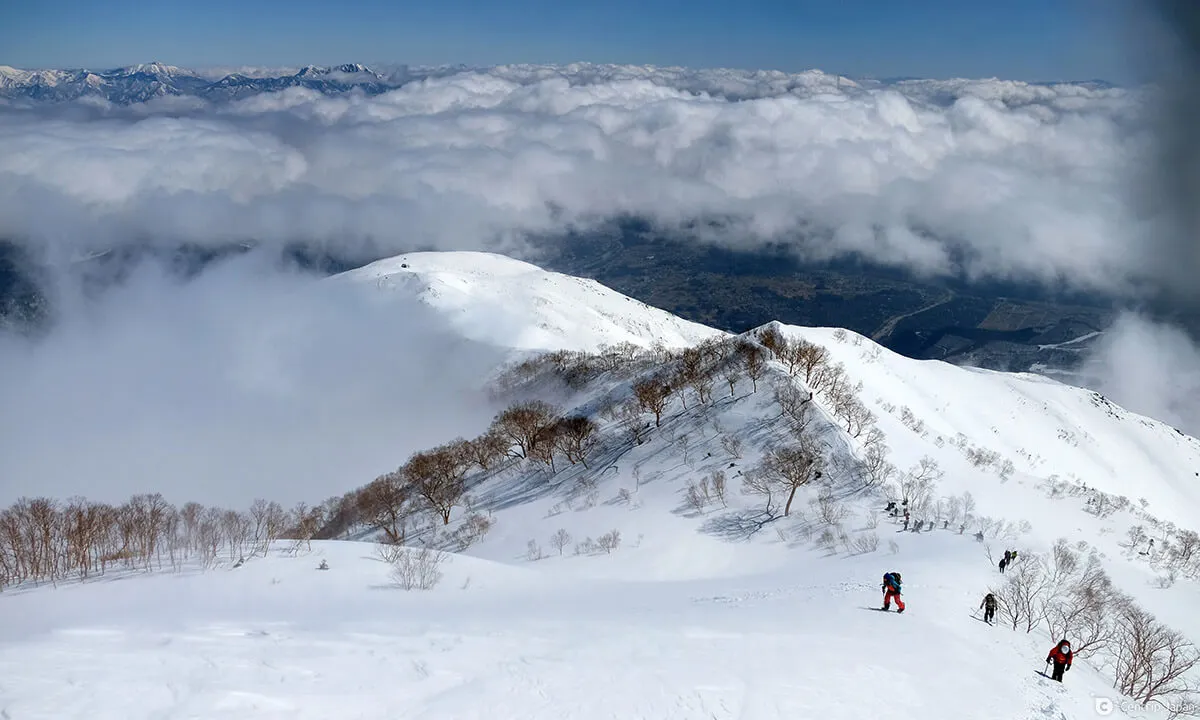 All but the tops of the trees are still buried under deep snow in early March
All but the tops of the trees are still buried under deep snow in early March
The panoramic views in every direction seem almost too beautiful to be real, and the single-file trains of hikers working their way up the ridge before and behind you add an awe-inspiring sense of scale to the grand, natural landscape.
 Two climbers following footprints in the snow under the shadow of Mt. Goryu
Two climbers following footprints in the snow under the shadow of Mt. Goryu
The further you climb, the more the view opens up, slowly revealing the uncut grandeur of the nearby mountains; beginning early with the three major Hakuba peaks, followed later by the formidable, jagged profile of the Kaerazu-no-ken, and culminating with remarkable vistas across to Mt. Tsurugi and Mt. Tateyama from the saddle upon which the Karamatsu-dake Chojo-sanso mountain hut sits.
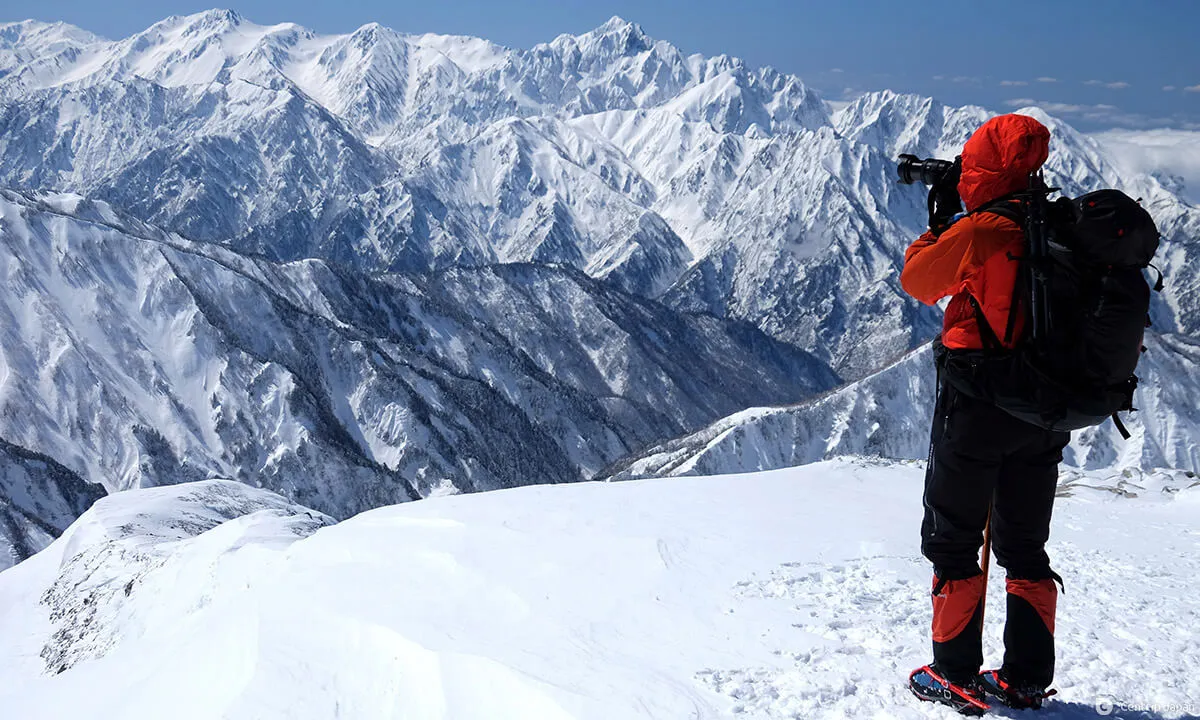 The sublime views of Tateyama and Tsurugi from the saddle below the summit
The sublime views of Tateyama and Tsurugi from the saddle below the summit
From the hut, which is closed in winter and spring except for the Golden Week holidays, the pyramidal peak of Karamatsu rises immediately before you, appearing tantalizingly close and frustratingly far all at once.
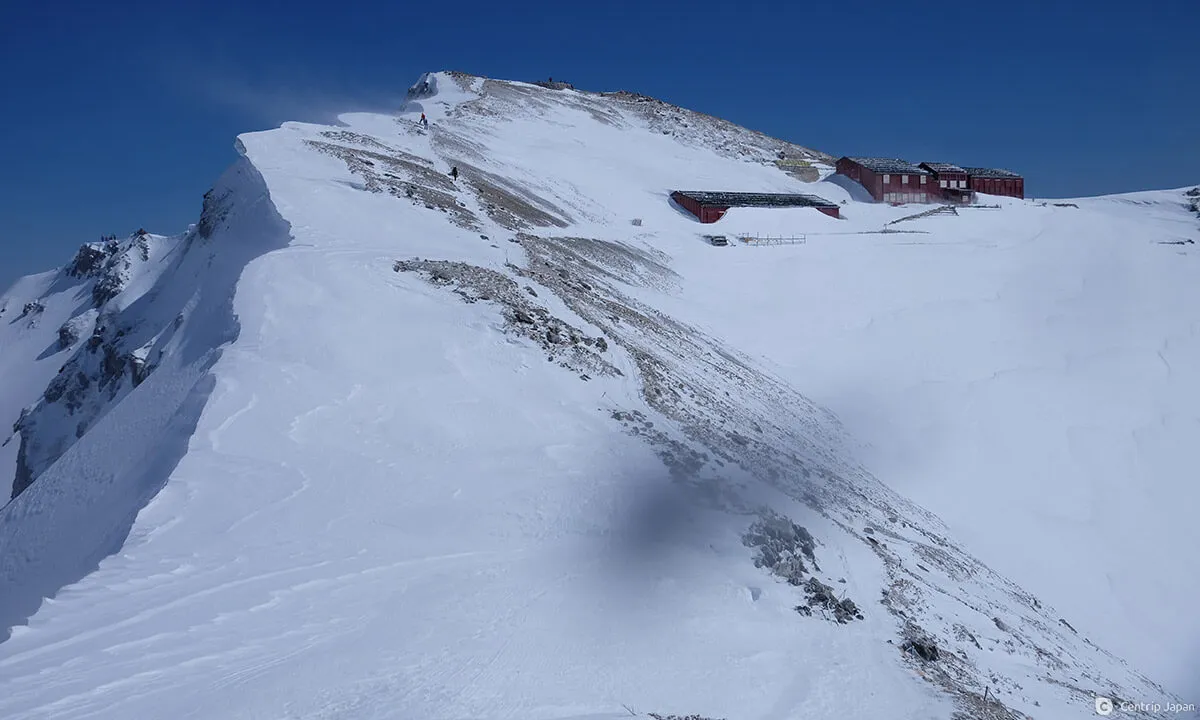 Looking back at the Karamatsu-dake Chojo-sanso mountain hut while on the final approach to the summit
Looking back at the Karamatsu-dake Chojo-sanso mountain hut while on the final approach to the summit
The final ascent can be done in less than half an hour, and the reasonably-broad summit area is a good place to take a break, snap photos and bask in your accomplishment (if the winds are calm) before turning around and making the 3-hour return trip.
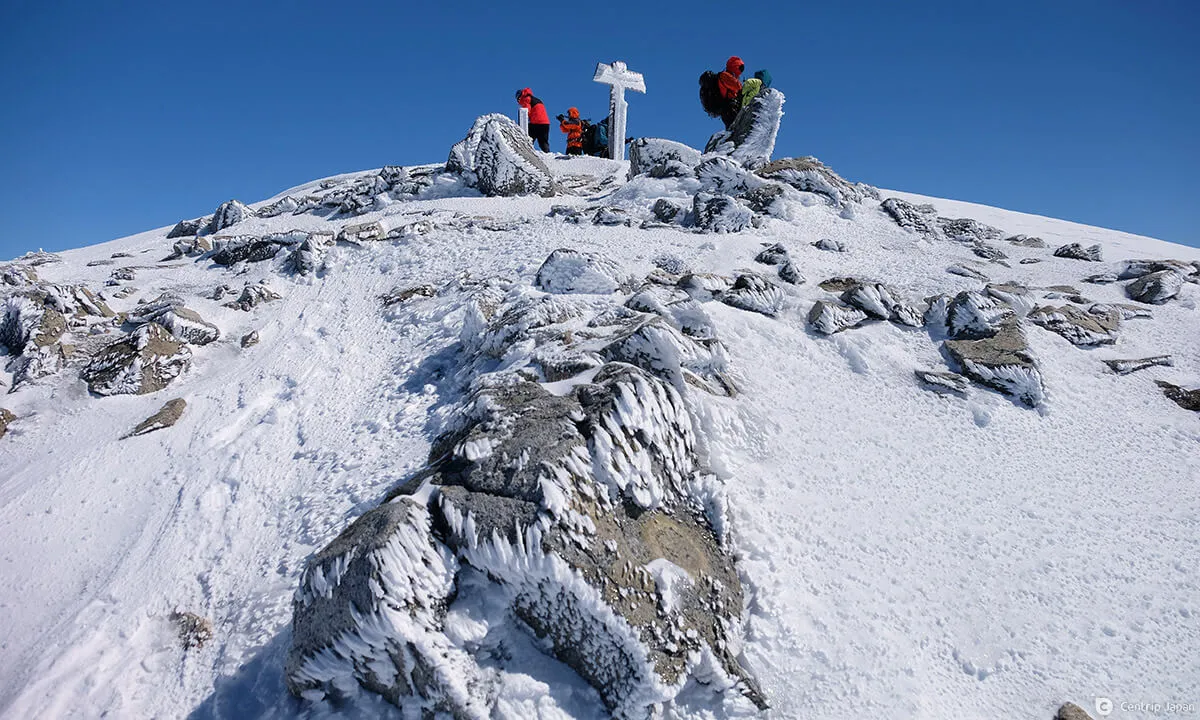 The wind-battered peak of Mt. Karamatsu
The wind-battered peak of Mt. Karamatsu
Route Data (Approximate)
Starting / Ending Point: Hakuba Happo-One Ski Resort
Total Elevation: +/- 865m
Total Distance: 9.3km
Estimated Walking Time*: 7 hours
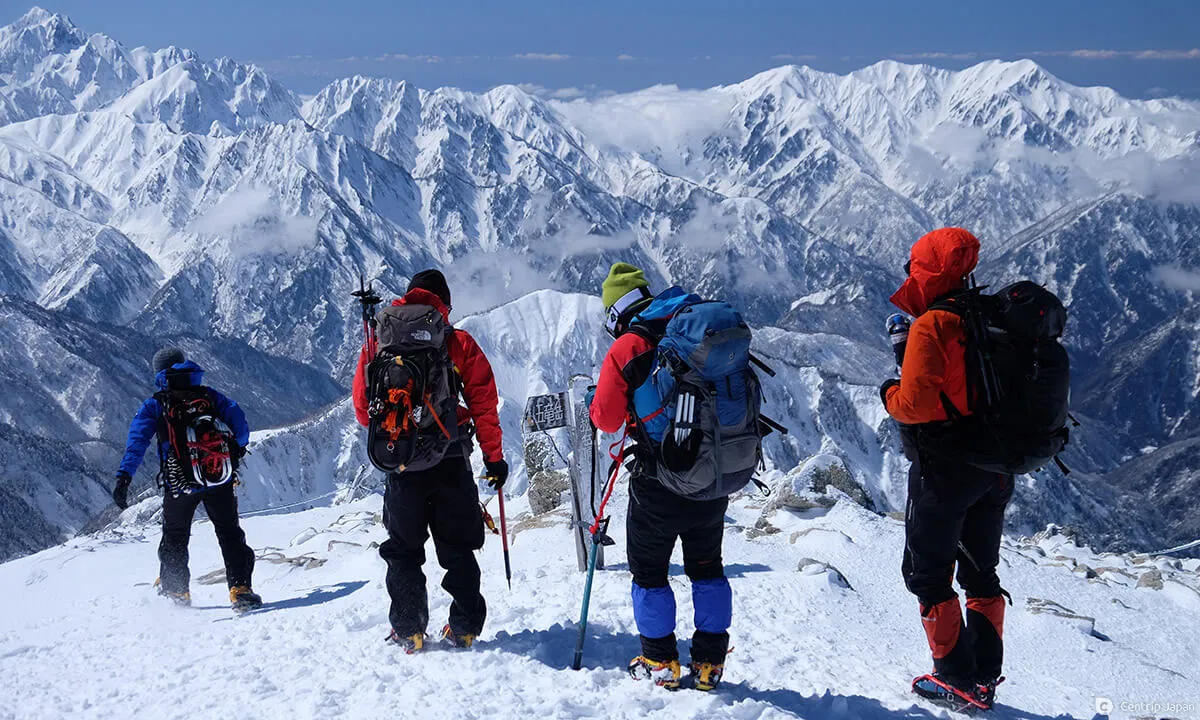 Climbers enjoying a break and the breathtaking views from their 2,696m perch
Climbers enjoying a break and the breathtaking views from their 2,696m perch
A Word of Caution
This is not a casual hike, but rather a difficult climb through rugged surroundings that presents a physical challenge in any season, as well as the potential for hazards brought on by weather, fatigue, altitude, and the general environment. Some dangers that are unique to or amplified by climbing in snow include the risk of avalanches and the increased potential for slips and falls. Other problems that might cause minor inconveniences during the warm summer months can quickly lead to far more serious situations during the colder snow season. It should also be noted that even once it looks and feels like summer in the city or spring here at the foot of the mountains, you must be packed and prepared for mid-winter conditions in the Alps, no matter the forecast.
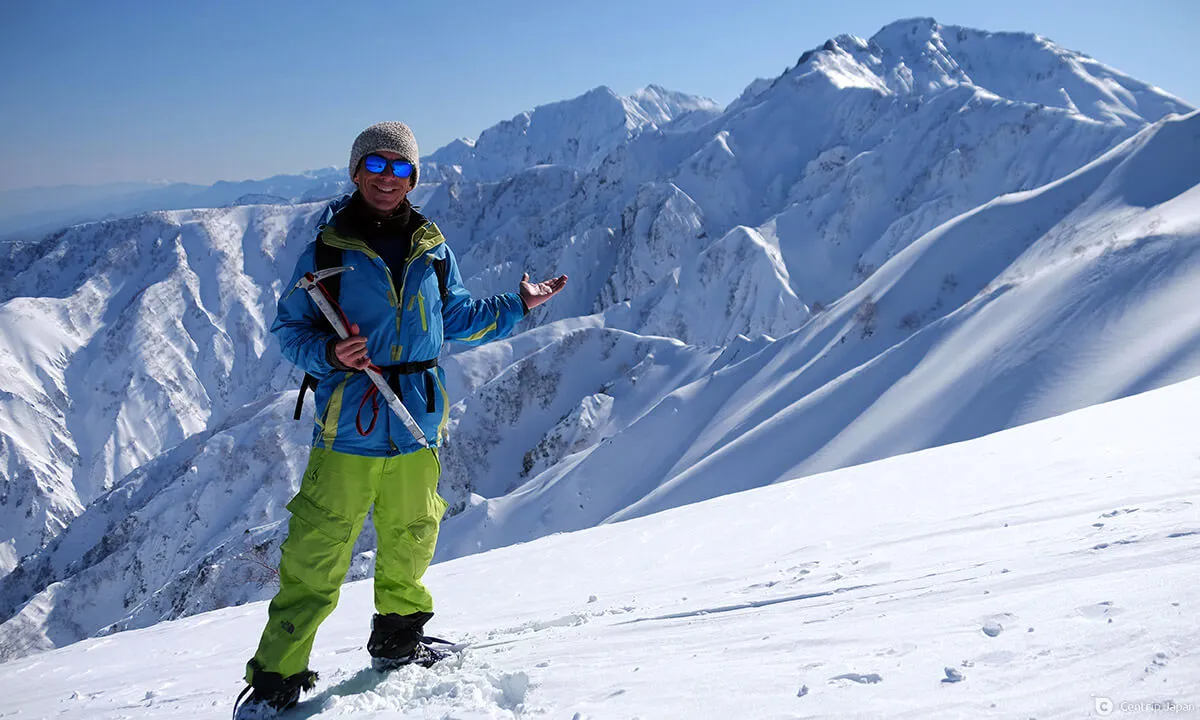 Be sure to pack an ice axe and wear proper 10-12 point crampons, warm waterproof boots, clothing, etc...
Be sure to pack an ice axe and wear proper 10-12 point crampons, warm waterproof boots, clothing, etc...
Please carefully consider the weather, your current fitness and experience levels, and the suitability of your gear (ice axe, crampons, etc...) and clothing before committing to a climb. Furthermore, be sure to create and submit an appropriate mountaineering plan* that gives you plenty of time to take the lifts up, reach the summit, and return to the resort in time to catch the final lift back down. (*Required. Compass is a useful online tool for making and submitting plans in advance.) Always be flexible and willing to turn back if the circumstances call for it, and if necessary, consider organizing a trip with an experienced and qualified guide.
Planning Your Hike
Getting to/from Hakuba
 A stone Jizo standing watch along the trail to Mt. Karamatsu
A stone Jizo standing watch along the trail to Mt. Karamatsu
One of the easiest and most dependable ways to get to Hakuba from Nagoya is to take the Limited Express Shinano (bound for Nagano) on the JR Line to Matsumoto Station and transfer to a local train on the Oito Line bound for Hakuba. It takes roughly 4 hours and costs just over ¥7,000 one way for a reserved seat. Some departures may require an additional transfer between Matsumoto and Hakuba at Shinano-Omachi station. The earliest trains depart Nagoya at 7:00, arriving in Hakuba at 11:06. Due to the significant time required to climb Karamatsu and the operating hours of the lifts, it is not possible to reach the summit on the same day.
Utilizing the Happo Lifts
The trio of gondolas and lifts used to reach the starting point for the climb to Karamatsu are collectively called the Happo Alpen Line and round-trip tickets for non-resort skiers (sightseers, hikers, and backcountry skiers) cost ¥3,800 for adults and ¥1,850 for children. One-way tickets are ¥2,500 and ¥1,000 respectively, and all are available for purchase at Happo Gondola Lift Ticket Center.
The Adam Gondola at the resort's base begins operating at 8:00 a.m., while the last chair down on the Grat Quad from the top of Happo leaves at 15:20. Once you factor in the 20-minute total ride time going up, this leaves you with 7 hours at most to complete your climb. Therefore, it is strongly recommended that you arrive early enough to line up, buy your ticket and get on the gondola as quickly as possible, ideally as it starts first thing in the morning.
When to Go
In general, the zansetsu hiking season kicks off in this part of the Alps around mid-March and lasts until early May. The start coincides with the end of major seasonal snowfalls and the beginning of longer days and warmer temperatures that lead to a firmer, more compact snow surface that is easier to travel on. In most years the Happo-One Ski Resort (and the Alpen Line) remains open for the winter season until the last day of Golden Week in early May, before closing temporarily and reopening for the summer green season in early June. Unless you're keen to hike up from the very bottom, you will want to time your visitd to use the lifts before the end of Golden Week.
Click here to get the latest information on Central Japan.Centrip Japan - Nagoya and Chubu Information

